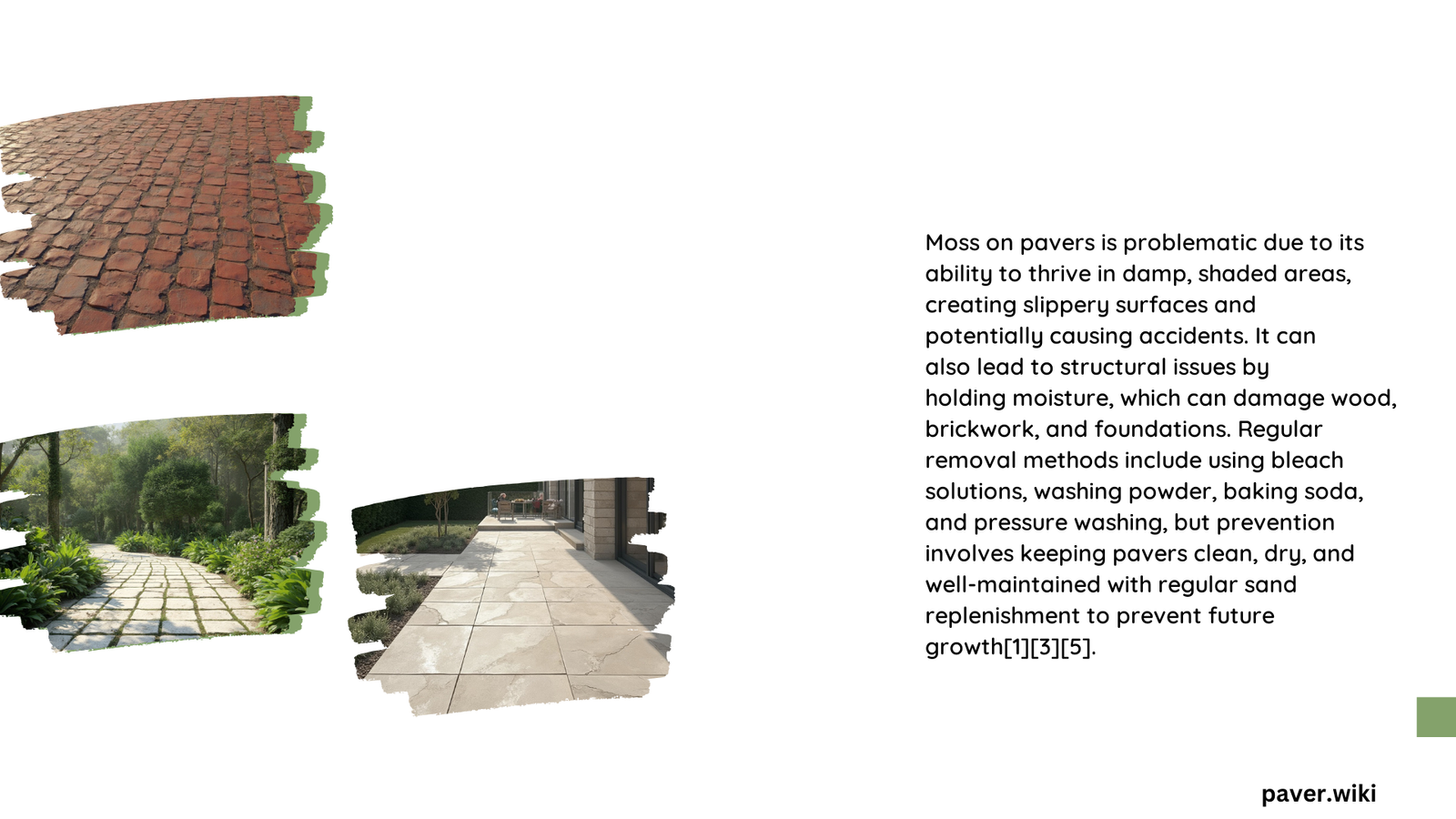Moss growth on pavers is a common issue that can significantly impact their durability and appearance. While it may seem harmless, moss can cause serious damage to pavers over time. This article explores the effects of moss on pavers, removal techniques, and preventative measures to help maintain the longevity and aesthetic appeal of your paved surfaces.
What Are the Negative Effects of Moss on Pavers?
Moss growth on pavers can lead to several problems:
- Structural damage
- Reduced lifespan
- Aesthetic issues
- Safety hazards
Structural Damage
Moss can cause significant structural damage to pavers through various mechanisms:
- Moisture retention: Moss holds water against the paver surface, leading to erosion and potential freeze-thaw damage.
- Root penetration: Moss roots can grow into small cracks and crevices, widening them over time.
- Weakening of mortar: In mortared pavers, moss can cause the mortar to deteriorate, compromising the overall stability of the paved area.
Reduced Lifespan
While exact figures vary, moss growth can significantly shorten the lifespan of pavers:
- Untreated moss can reduce paver lifespan by several years.
- Regular maintenance and moss removal can extend paver life by 5-10 years or more.
Aesthetic Issues
Moss growth can detract from the appearance of pavers:
- Creates a patchy, unkempt look
- Can cause permanent staining on lighter-colored pavers
- Obscures the original color and texture of the paving material
Safety Hazards
Moss-covered pavers can pose safety risks:
- Increased slipperiness, especially when wet
- Uneven surfaces due to moss growth, creating trip hazards
How Can Moss Be Effectively Removed from Pavers?

Several methods can be used to remove moss from pavers:
- Chemical treatments
- Mechanical removal
- Professional cleaning services
Chemical Treatments
| Method | Pros | Cons | Cost |
|---|---|---|---|
| Vinegar solution | Eco-friendly, inexpensive | May damage some paver types | $1-2 per gallon |
| Bleach solution | Highly effective | Environmental concerns, potential paver damage | $2-3 per gallon |
| Commercial moss killers | Specifically formulated for moss | More expensive, may contain harsh chemicals | $10-20 per bottle |
Mechanical Removal
- Pressure washing: Effective but can damage some paver types if not done carefully
- Scrubbing with a stiff brush: Labor-intensive but safe for most pavers
- Specialized tools: Paver cleaning attachments for power washers or dedicated paver cleaning machines
Professional Cleaning Services
For extensive moss growth or delicate paver materials, professional cleaning services offer:
- Specialized equipment (e.g., DOFF cleaning, steam cleaning)
- Expertise in handling different paver types
- Comprehensive cleaning and sealing services
Cost: Typically ranges from $100 to $300 for an average-sized patio or driveway
What Preventative Measures Can Be Taken Against Moss Growth on Pavers?
Preventing moss growth is key to maintaining paver longevity:
- Proper drainage
- Regular cleaning
- Sealing
- Sunlight exposure
Proper Drainage
Ensure good drainage to prevent water accumulation:
- Slope pavers away from structures
- Install proper drainage systems
- Address any areas of standing water
Regular Cleaning
Implement a regular cleaning schedule:
- Sweep or blow debris off pavers weekly
- Perform a deep clean every 6-12 months
- Address any moss growth immediately upon detection
Sealing
Apply a quality paver sealer:
- Creates a protective barrier against moisture and moss spores
- Reapply every 2-3 years for optimal protection
- Choose a sealer appropriate for your paver type
Sunlight Exposure
Maximize sunlight exposure to deter moss growth:
- Trim overhanging vegetation
- Consider relocating potted plants that create shady areas
- Design paved areas with sunlight exposure in mind
How Does Moss Impact Paver Longevity in Different Environmental Conditions?
The impact of moss on paver longevity varies depending on environmental factors:
Climate Factors
- Humid climates: Increased risk of moss growth and associated damage
- Freeze-thaw cycles: Exacerbate damage caused by moisture retention in moss
- Shaded areas: More prone to persistent moss growth
Paver Material Considerations
Different paver materials react differently to moss growth:
- Concrete pavers: Generally more resistant but can suffer from staining
- Natural stone: More susceptible to erosion and damage from moss roots
- Clay brick pavers: Can experience significant deterioration if moss is left untreated
Long-term Effects
Prolonged moss growth can lead to:
- Accelerated weathering of paver surfaces
- Increased maintenance costs over time
- Potential need for premature paver replacement
By understanding the negative impacts of moss on pavers and implementing effective prevention and removal strategies, you can significantly extend the life and maintain the beauty of your paved surfaces. Regular maintenance and prompt attention to moss growth are key to preserving the integrity and appearance of your pavers for years to come.
References:
1. https://cis1976.com/knowledge-base-2/the-impact-of-algae-and-moss-on-the-longevity-of-stone-and-brick-structures/
2. https://www.icecleaning.co.uk/blog/how-to-clean-moss-off-brick
3. https://oldtownpavers.com/the-impact-of-heavy-traffic-on-paver-durability/
